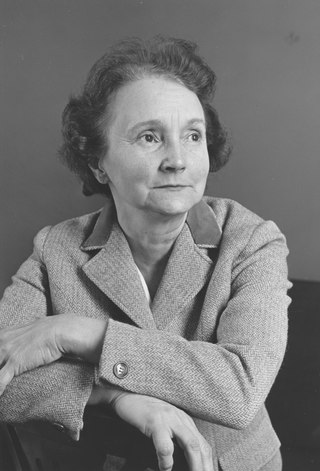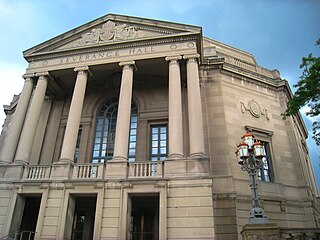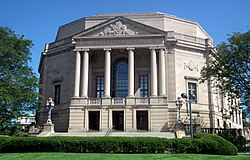
The Cleveland Orchestra is an American orchestra based in Cleveland, Ohio. Founded in 1918 by the pianist and impresario Adella Prentiss Hughes, the orchestra is one of the five American orchestras informally referred to as the "Big Five". The orchestra plays most of its concerts at Severance Hall. Its current music director is Franz Welser-Möst.

Erich Leinsdorf was an Austrian-born American conductor. He performed and recorded with leading orchestras and opera companies throughout the United States and Europe, earning a reputation for exacting standards as well as an acerbic personality. He also published books and essays on musical matters.

Lorin Varencove Maazel was an American conductor, violinist and composer. He began conducting at the age of eight and by 1953 had decided to pursue a career in music. He had established a reputation in the concert halls of Europe by 1960 but, by comparison, his career in the U.S. progressed far more slowly. He served as music director of The Cleveland Orchestra, Orchestre National de France, Pittsburgh Symphony Orchestra, Bavarian Radio Symphony Orchestra, and the New York Philharmonic, among other posts. Maazel was well-regarded in baton technique and possessed a photographic memory for scores. Described as mercurial and forbidding in rehearsal, he mellowed in old age.

George Szell, originally György Széll, György Endre Szél, or Georg Szell, was a Hungarian-born American conductor and composer. Considered one of the twentieth century's greatest conductors, he was music director of the Cleveland Orchestra of Cleveland, Ohio, and recorded much of the standard classical repertoire in Cleveland and with other orchestras.

The Bridgewater Hall is a concert venue in Manchester city centre, England. It cost around £42 million to build in the 1990s, and hosts over 250 performances a year. It is home to the 165-year-old Hallé Orchestra as well as to the Hallé Choir and Hallé Youth Orchestra and it serves as the main concert venue for the BBC Philharmonic.

Orchestra Hall is a concert hall that is located on 11th Street at Peavey Plaza in downtown Minneapolis, Minnesota. The home of the Minnesota Orchestra, it is a major landmark of the southern portion of Nicollet Mall and hosts many events throughout the year, in addition to being the Orchestra's home.

The Bell Telephone Hour was a concert series that began April 29, 1940, on NBC Radio, and was heard on NBC until June 30, 1958. Sponsored by Bell Telephone as the name implies, it showcased the best in classical and Broadway music, reaching eight to nine million listeners each week. It continued on television from 1959 to 1968. Throughout the program's run on both radio and television, the studio orchestra on the program was conducted by Donald Voorhees.

Liverpool Philharmonic Hall is a concert hall in Hope Street, in Liverpool, England. It is the home of the Royal Liverpool Philharmonic Society and is recorded in the National Heritage List for England as a designated Grade II* listed building. It is not the original concert hall on the present site; its predecessor was destroyed by fire in 1933 and the present hall was opened in 1939.

Christoph von Dohnányi is a German conductor.

Blossom Music Center, locally referred to simply as Blossom, is an outdoor amphitheatre in Cuyahoga Falls, Ohio, United States. The venue is the summer home of The Cleveland Orchestra and the site of the ensemble’s annual Blossom Festival. Blossom Music Center is owned by the Musical Arts Association, the Orchestra’s parent organization.

Municipal Auditorium is a multi-purpose facility located in Kansas City, Missouri. It opened in 1935 and features Streamline Moderne and Art Deco architecture and architectural details.

Public Auditorium is a multi-purpose performing arts, entertainment, sports, and exposition facility located in the civic center district of downtown Cleveland, Ohio. The 10,000-capacity main auditorium shares its stage with a second venue housed at the facility: the 3,000-capacity Music Hall. Although Public Auditorium was planned and funded prior to World War I, construction did not begin until 1920, and the building did not open until 1922. Designed by city architect J. Harold McDowell and Frank Walker of Walker and Weeks in a neoclassical style matching the other Group Plan buildings, it was the largest of its kind when opened, then seating 11,500.

Nikolai Grigoryevich Sokoloff was a Ukrainian-American conductor and violinist.

Walker and Weeks was an architecture firm based in Cleveland, Ohio, founded by Frank Ray Walker and Harry E. Weeks.

Adella Prentiss Hughes was a pianist and impresaria based in Cleveland, Ohio. She is best known for founding The Cleveland Orchestra.

Alice Chalifoux was the principal harpist with the Cleveland Orchestra from 1931 to 1974 and was its only female member for twelve years. Chalifoux learned to play the harp from her mother, studying music at local schools before studying under Carlos Salzedo at the Curtis Institute of Music. She was an authority on his music and took over the Salzedo Summer Harp Colony after his death. She had a reputation as a specialist in orchestral harp technique and a master teacher. She taught at the Cleveland Institute of Music, the Oberlin Conservatory of Music, and the Baldwin-Wallace Conservatory of Music. She continued teaching harp until her death in 2008, at the age of 100. Chalifoux received two honorary degrees for her work. In her personal life, Chalifoux married John Gordon Rideout in 1937 and had one daughter.
The Cleveland Orchestra, which was founded in 1918, was first recorded in 1924. Most of the orchestra's recordings have been made either in its concert home, Severance Hall, or in nearby Masonic Auditorium.

The Cleveland Orchestra Youth Orchestra (COYO) is a group of 100 young musicians, selected from over 45 cities across Ohio and Pennsylvania.

John Long Severance was a businessman and philanthropist in Cleveland, Ohio.

William Thomas Appling was a renowned American conductor, pianist, educator and arranger. As a conductor he led the William Appling Singers & Orchestra for almost twenty-five years and conducted other choirs and musical organizations, premiering new works by many American composers. As a pianist he played under the batons of conductors including Robert Shaw, Louis Lane, and Darius Milhaud, and he was the first African American to record the complete piano music of Scott Joplin. As an educator he taught at American schools and universities including Vassar College, Case Western Reserve University, the Cleveland Institute of Music and Western Reserve Academy. He made a number of recordings as both conductor and pianist, and his choral arrangements have been performed and recorded by such prominent ensembles as Chanticleer, Cantus and Dale Warland Singers.






















